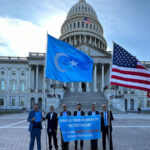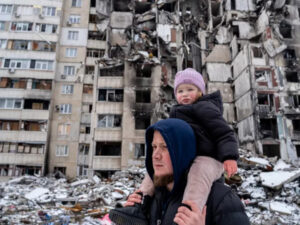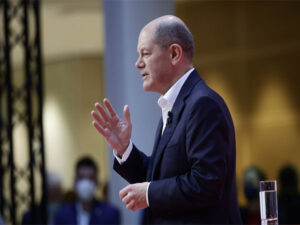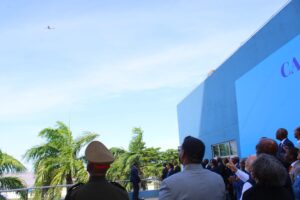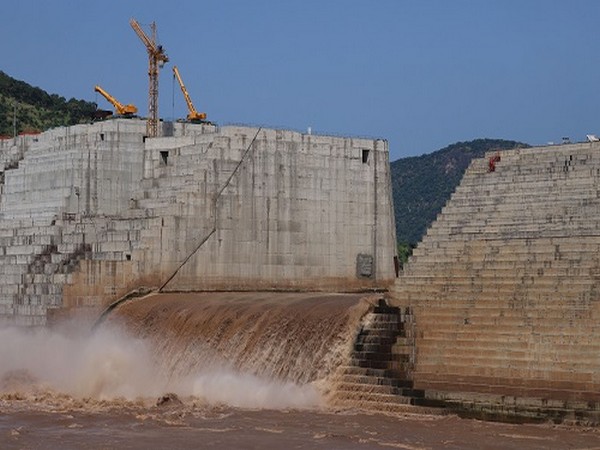
Water flows through Ethiopia's Grand Renaissance Dam as it undergoes construction work on the river Nile in Guba Woreda, Benishangul Gumuz Region, Ethiopia September 26, 2019. Picture taken September 26, 2019. REUTERS/Tiksa Negeri - RC18957504D0
By John Solomou
Nicosia [Cyprus], July 26 (ANI): The announcement made by the Ethiopian government last week that it completed the second phase of filling the giant Grand Renaissance Dam (GERD), which is Africa‘s largest dam, angered Egypt and Sudan.
These two countries fear that they will be deprived of quantities of water that are vital for their populations and their economy. Egypt which used diplomatic means to prevent the quick filling of the dam and has even threatened to use military force against Ethiopia has seen its efforts fallen flat on its face and were completely ignored by Addis Ababa.
Egypt and Sudan have been locked in a decades-long dispute with Ethiopia over the dam, due to Addis Ababa’s insistence to fill the dam’s reservoir without reaching a binding agreement with its downstream neighbours.
On Thursday, thousands of Ethiopian government supporters gathered in a central square in Addis Ababa to celebrate the second filling of the Grand Ethiopian Renaissance Dam. They expressed their support for the government, that the filling of GERD is a natural part of the process for the construction of the dam and cannot be stopped.”
Seleshi Bekele, Ethiopia’s Minister for Water, Irrigation and Energy had earlier tweeted: “The second filling of the Renaissance dam has been completed and the water is overflowing. This means we have now the needed volume of the water to run the two turbines.” Now the project can start producing desperately needed electricity, as currently 60 per cent of Ethiopia’s population are not connected to the grid.
The question of the Grand Renaissance Dam over the Blue Nile has incited strong nationalist fervor in Egypt, because 90 per cent of all its water comes from the Nile. A serious reduction in the volume of water flowing from Ethiopia would have dire consequences on Egypt’s 100 million population, which grows by 2 million a year. Egyptian economists estimate that, due to the building of the dam, Egypt could lose 10 billion cubic meters of water a year out of the 50 million cubic meters it received up to 2019. This would have a serious impact on irrigated land and agriculture that provides employment to 30 per cent of the country’s workforce.
Egyptian President Abdel al-Fattah al-Sissi had warned last March that “the waters of the Nile are a red line, and any encroachment on Egypt’s water will be met with a response that will imperil the stability of the entire region.”On 15 July al-Sisi, stressed that any reduction of Egypt’s water supply is a red line that “cannot be crossed,” adding: “Before anything happens to Egypt, the army and I would have to be gone.”
When the Ethiopian government informed Cairo at the beginning of July that it would start the second phase of filling the dam, the Egyptian Ministry of Irrigation informed the United Nations Security Council of its categorical rejection of Addis Ababa’s move and warned that the “unilateral measure could lead to creating a situation that threatens security and peace at the regional and international levels.”
For its part, Sudan’s Irrigation Ministry in a statement rejected “unilateral measures from neighbouring Ethiopia and policies of imposing a fait accompli and ignoring the legitimate interests and serious concerns of its river partners”. It also called on the Ethiopian government to continue negotiations aimed at concluding a binding and comprehensive legal agreement that preserves the interests of all parties”. Sudan claims that it has lost 50 per cent of its share of the water as a result of the filling of the reservoir.
In a threatening move last month, Egypt and Sudan held joint military exercises called “Guardians of the Nile”, but this failed to make the Ethiopian government change its mind. Addis Ababa ignored the threat, encouraged by the fact that the UN Security Council at its meeting on July 9, convened at the request of Egypt and Sudan, refrained from making a decision on the subject of the dam, and simply expressed support for the mediation efforts made by the Organization of African Unity.
The reason for the reluctance of Security Council members to intervene in the dispute is that China and Russia are big investors in Ethiopia – although they were not involved in financing the construction of the dam, estimated to cost about 5 billion US dollars. Moreover, the Italian Company “Webuild” has the contract to build the main infrastructure of the dam, while companies of the United States, France and Germany are involved in the supply and installation of turbines in the power station.
The United States has said Ethiopia’s filling of the dam had the potential to raise tensions and has urged all parties to refrain from any unilateral actions.
Egyptian space scientist Essam Hajji, who was involved in the development of a model to calculate the current and future water deficit in groundwater for all North African countries and the Arabian Peninsula due to climate change says: “If the growing water deficit is not addressed properly, Egypt could lose up to 72 per cent of its agricultural area, the unemployment rate could increase from 14 per cent to 25 per cent, and agricultural production could lose up to 51 billion US dollars in three years, and then the average income of the average citizen will decrease by 8 per cent. These are undoubtedly catastrophic outcomes which should not be ignored in any way.”
It is believed that Cairo will continue to try to reach an agreement with Addis Ababa and use all diplomatic means at its disposal to solve the dispute but will not launch a war as clearly on this issue it does not enjoy the support of the big powers or even the support of wealthy Arab countries, like Saudi Arabia, the UAE, or Qatar which have made big investments in Ethiopia. (ANI)




